Abstract
Alley cropping is a sustainable agriculture approach that improves ecosystem services while also promoting biodiversity. The current study was conducted over two seasons, 2019/2020 and 2020/2021, to examine the impact of leucaena–turmeric alley cropping and organic compost addition as agroforestry systems on the growth, yield and characteristics of the turmeric crop. Alley cropping included four treatments: control (turmeric as sole crop), turmeric cultivated between leucaena trees pruned at 1 m height, leucaena trees pruned at 1.5 m height and unpruned leucaena trees. Meanwhile, organic compost rates were control (received recommended NPK) and 17 and 34 m3 ha−1. This study’s results showed that growing turmeric in between rows of unpruned leucaena resulted in maximum turmeric plant growth, production and characteristics. Minimum turmeric growth and yield parameters were recorded with plants grown between pruned leucaena at 1 m and those where the turmeric was the sole crop. In addition, compost addition at 34 m3 ha−1 led to maximum growth, yield and attributes of the turmeric crop. Compost addition and alley cropping were shown to be an effective and sustainable agro-ecological system for increasing turmeric output and quality. The study demonstrated the importance of selecting the appropriate crop–tree combination in this system and it was discovered that leguminous leucaena trees significantly contributed to improving fertility and nutrient availability, which in turn improved the growth characteristics of turmeric, particularly the leaf-area index and its nutrient content, which are beneficial to the characteristics of the rhizome yield and curcumin content.
1. Introduction
Sustainable farming refers to agricultural systems and procedures that try to reduce the depletion of natural resources in the soil. Sustainable farming approaches strive to preserve more organic matter in the soil, reduce erosion and keep more carbon in the soil. These practices improve the resilience and long-term health of the soil, ultimately leading to higher yields. Sustainable agriculture development should achieve a balance between economic and environmental/social goals []. One of the most pressing concerns faced due to climate change, food insecurity and a dwindling agricultural resource base is how to build profitable farming systems that optimize the use of arable land and enhance farmer incomes. Agroforestry, which allows farmers to efficiency use their land resources at reduced environmental costs while producing a range of crops at different times, neatly solves these difficulties [].
Agroforestry is a farming practice suitable for enhancing the ecosystem services produced by cropping systems. Among agroforestry systems, the alley-cropping system is characterized by the intercropping of crops and wide-row trees []. These systems offer a variety of products, including food, feed, fibers, fuel wood and timber, in addition to increasing the potential delivery of agro-ecosystem services [].
Comparing to conventional agricultural practices, alley cropping is a more ecologically friendly strategy for land usage, biomass generation and sustainable food production. Alley cropping can deliver biomass resources in a sustainable manner and benefit the environment at the same time because it is a highly adaptable, low-input system []. In alley-cropping, a primary crop species is intercropped with a different plant species that grown in numerous horizontal strips []. With a variety of crop plants, trees, ground-vegetation cover and plant canopy, alley-cropping can provide complex vegetation structural diversity compared to monocultures, improving soil fertility (depending on the used species), water quality and carbon cycling [,].
Alley-cropping also serves as a potential adaptation strategy for reducing the consequences of climate change throughout its ecological advantages, such as buffers for weather extremes, reduced soil erosion, increased biodiversity and efficient nutrient and water utilization []. One problem of combining crop production with trees is that they may compete for nutrients, water and light, especially in areas where these resources are scarce []. Several researchers have found that due to competition, alley cropping diminished crop and/or tree yields, but its land-use efficiency was still high [,,]. Because of the potential loss in crop yield, farmers are often hesitant to implement agroforestry systems [,]. Alley cropping enables the farmers to effectively utilize available resources and yield more benefits. Choosing suitable associated crops and mitigating the competition between trees and crops is crucial in designing alley-cropping systems [].
Agroforestry and livestock feeding systems that use leguminous plants show potential for bridging the enormous demand and supply gaps in terms of animal feed and fodder. Leucaena (Leucaena leucocephala), is a miracle tree known for its rapid growth, versatility, capacity to fix nitrogen, adaptation to a variety of environments, strong coppicing ability, etc. and it finds usage in an agroforestry system []. Due to all these properties, Leucaena has become a model tree for alley farming. In alley farming, hedgerow trees are kept clipped throughout the cropping season to reduce crop shade and increase crop output [,].
On the other hand, organic farming impacts the physical, chemical and biological characteristics of soil, which in turn improves its fertility. It is considered an environmentally safe source, reduces pollution, is a renewable source for plant and soil nutrition and is less expensive compared to chemical fertilizers. Organic farming has increased tremendously in importance over the past 20 years, including in developing countries and the global market for organic products has grown [].
Turmeric (Curcuma longa L.) is an herbaceous perennial crop belonging to the family Zingiberaceae. It is used in medicines, cosmetics and drugs as well as in food industries. Most chemical compositions consist of pale yellow to the orange-yellow volatile oil, which is composed of number of sesquiterpenes, monoterpenes, zingeberene, α-and β-turmerone, curcumin and other components. The rhizome also has an important role in indigenous medicine, as well as in anti-cancer and anti-viral activities. This plant incorporates a yellowish coloring known as curcumin, starch, an acrid volatile oil, calcium chlorides, gum and woody fiber []. Due to the growing importance of this plant, as well as the fact that the curcuma plant is one of the finest and most costly in the global market, there is a lack of information on its growth and chemical makeup in Egyptian conditions. Finding the best agricultural practices to improve its traits and active substances is of utmost significance [].
The current experiment was to study the growth, yield and attribute performance of turmeric as a valuable medicinal crop under the alley-cropping system of leucaena–turmeric and organic-compost supplementation in newly reclaimed lands in Upper Egypt.
2. Materials and Methods
The current study was carried out over two seasons, 2019/2020 and 2020/2021, on recently reclaimed lands of the Agricultural Research Station in Al-Marashda, Agriculture Research Centre, Qena governorate, Egypt (latitude 26°09′ N, longitude 32°42′ E). Fresh seeds of leucaena (Leucaena leucocephala) were obtained from healthy trees on the Al-Marashda farm. Seeds were soaked in previously boiled water for 2 h and were then sown in rows 2 × 4.5 m apart in February 2019 and 2020. The trees were left without pruning until the date of turmeric planting on 1 November of each year. Rhizomes of turmeric (Curcuma longa) were obtained from Sekem Companies, Cairo, Egypt. The chemical and physical properties of the soil are shown in Table 1 and the chemical analysis of the used irrigation water for the experimental site is shown in Table 2. The other agricultural practices were carried out as recommended for the cultivation of the turmeric plant by the Agricultural Research Centre, Ministry of Agriculture and Water Resources, Egypt.

Table 1.
Physical and chemical characteristics of the experimental soil site.

Table 2.
Chemical analysis of the used irrigation water for the experimental site.
2.1. Experimental Design
This experiment used a split-plot design with 12 combination treatments and 3 replicates. The main plot was assigned for organic-compost treatments: control (recommended NPK fertilization; 26 units 15% calcium super phosphate, 50 units 33.5% ammonium nitrate and 38 units 48% potassium sulphate), 17 m3 ha−1 or 34 m3 ha−1 during the preparation of soil before planting turmeric rhizomes. The chemical properties of the used organic compost in this study are shown in Table 3. On 1 November, leucaena trees were periodically pruned at a height of 1 m or 1.5 m or left without pruning. The sub plot was assigned for turmeric alleyed between leucaena trees in an alley-cropping system: control (turmeric as a sole crop), leucaena pruned at 1 m, leucaena pruned at 1.5 m, or leucaena with no pruning. The turmeric rhizomes were planted in rows at a distance of 20 cm between plants and 50 cm between rows and the experimental plot was 2 × 4.5 m.

Table 3.
Chemical analysis of the used compost in the experimental site.
2.2. Growth and Yield Parameters
On 1 May in each season, the plant height (cm), number of tillers plant−1, leaf-area index (cm2), number of rhizomes per plant, fresh weight of rhizomes per plant (g), fresh weight of rhizomes per plot (kg) and yield of rhizomes per hectare (ton) were measured on six randomly selected plants from each treatment.
2.3. Chemical Analysis
The essential oil % was determined in each treatment by using the hydro-distillation method of the American Spice Trade Association []. In addition, curcumin content (%) was determined using the method described by Manjunath et al. [].
A leaf sample was collected from each turmeric plant and dried at 70 °C for 24 h. It was ground and digested to determine the content of nitrogen, phosphorus and potassium. The N content was determined using the modified microKjedahl method, as described by Jackson [], while the P content was estimated calorimetrically according to method of Murphy and Riley []. Potassium percentage was determined by using atomic absorption flame photometry (3300), as described by Wilde et al. [].
2.4. Statistical Analysis
Obtained data from the two seasons were tabulated, pooled and subjected to statistical analysis by using Michigan Statistical Program Version C (MSTATC). The analysis of variance (ANOVA) was performed and the means were compared using the least significant differences (LSD) test at 5% level [].
3. Results
ANOVA analysis revealed that turmeric growth, yield and attributes significantly differed as they were affected by compost doses, alley-cropping systems and the interactions between these. Increasing the compost dose led to significant increments in vegetative growth parameters: plant height, tiller number per plant, leaf-area index and rhizome number per plant (Figure 1). In the same way, the fresh weight of rhizomes per plant and rhizome yield per hectare significantly increased with increasing compost dose (Figure 2). Leaf nitrogen, phosphorus and potassium content also clearly increased with increasing the compost doses from 17 to 34 m3 ha−1 (Figure 3). Essential-oil content also increased significantly with increasing compost dose, although curcumin concentration did not alter much at 17 m3 ha−1 compost dose, but significant increments were shown at the compost dose of 34 m3 ha−1 with respect to control (Figure 4). The maximum values of all vegetative growth, yield parameters and attributes were observed under the 34 m3 ha−1 dose of compost treatment.
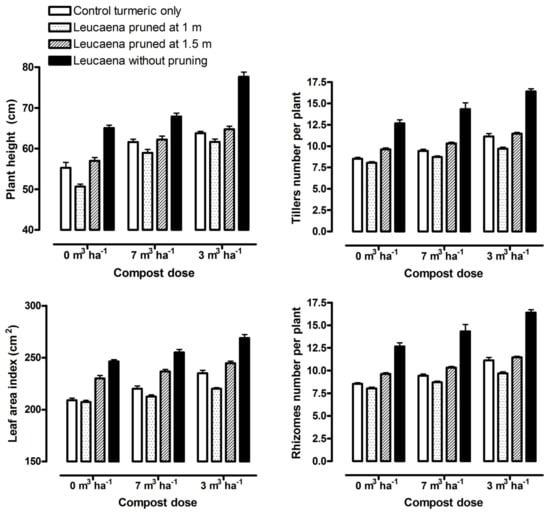
Figure 1.
Plant height (cm), tiller number per plant, leaf-area index (cm2) and number of rhizomes per plant of Curcuma longa in response to alley-cropping and organic-compost treatments as pooled data of the two seasons of 2021 and 2022.
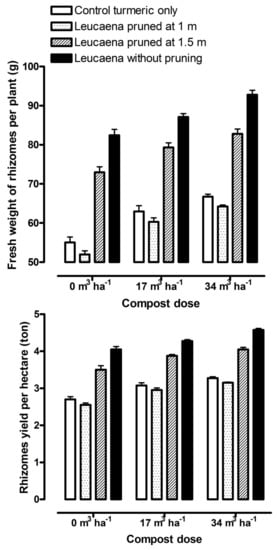
Figure 2.
Fresh weight of rhizomes per plant (g) and fresh weight of rhizomes per hectare (ton) of Curcuma longa in response to alley-cropping and organic-compost treatments as pooled data of the two seasons of 2021 and 2022.
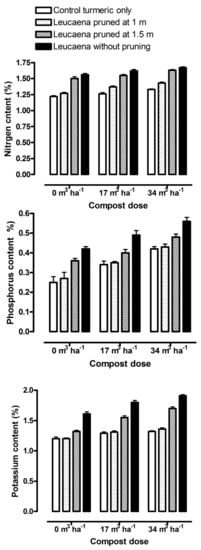
Figure 3.
Nitrogen, phosphorus and potassium contents (%) in leaves of Curcuma longa in response to alley-cropping and organic-compost treatments as pooled data of the two seasons of 2021 and 2022.
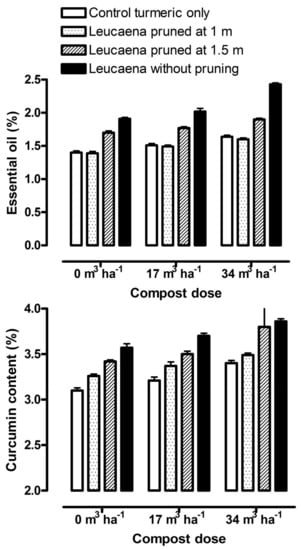
Figure 4.
Essential oil (%) and curcumin (%) in rhizomes in of Curcuma longa in response to alley-cropping and organic-compost treatments as pooled data of the two seasons of 2021 and 2022.
In terms of alley-cropping treatments, compared to the control (turmeric plants as a sole plant), the vegetative growth and yield parameters had significantly lower values when turmeric was alleyed between leucaena trees pruned at 1 m, while turmeric alleyed between leucaena trees pruned at 1.5 m and leucaena trees with no pruning had significantly higher values (Figure 1 and Figure 2). Meanwhile, there were no significant differences between the control and turmeric alleyed within leucaena trees pruned at 1 m in terms of chemicals, essential oil, or curcumin content, while significant increments clearly appeared when turmeric was alleyed between leucaena trees pruned at 1.5 m and leucaena trees with no pruning (Figure 3 and Figure 4). All vegetative growth, yield parameters and attributes were significantly higher when turmeric was alleyed between non-pruned leucaena trees.
All in all, the highest values of vegetative growth and yield parameters as well as chemical, essential oil and curcumin content were found in turmeric plants alleyed between leucaena trees with no pruning and treated with compost at a dose of 34 m3 ha−1. The lowest values of vegetative growth and yield parameters were seen in turmeric plants alleyed between leucaena trees pruned at 1 m and the lowest chemical, essential oil and curcumin content was found when turmeric was grown as a sole crop (control).
Leaf-area index is significantly associated with the vegetative growth and yield traits especially tiller number per plant, rhizome number per plant and rhizome yield (99, 96 and 97%, respectively), as shown in Figure 5. The amount of micronutrients in turmeric leaves increased as a result of increasing of soil’s fertility and nutrient availability due to compost addition as well as nitrogen fixation by leguminous leucaena trees. The yield of rhizomes was associated mainly with nitrogen and potassium content (95 and 96%, respectively). In addition, the micronutrients nitrogen, phosphorus and potassium were highly associated with curcumin content (95, 94 and 93%, respectively), as shown in Figure 6.
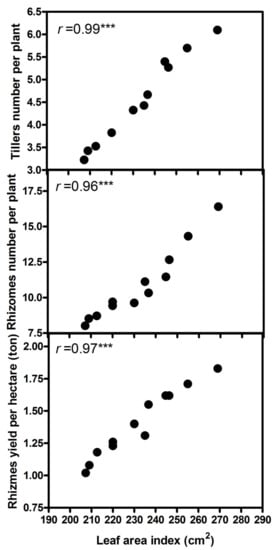
Figure 5.
Coefficient correlation of leaf-area index and tiller number per plant, rhizome number per plant and rhizome yield per hectare. *** Significance at probability level of < 0.0001.
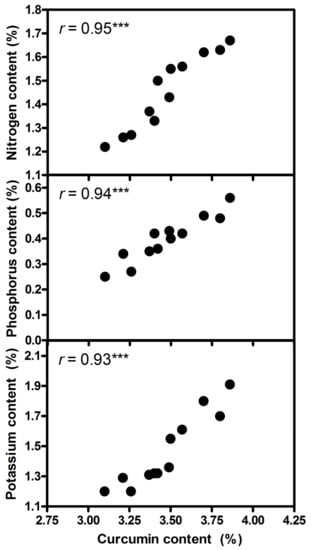
Figure 6.
Coefficient correlation of curcumin content and nitrogen, phosphorus and potassium contents. *** Significance at probability level of < 0.0001.
4. Discussion
A key issue in agroforestry management is the need to maximize mutual benefits and minimize interspecific competition between all components, allowing agroforestry to achieve high efficiency and sustainability []. Alley cropping is an agroforestry strategy that involves growing crops between closely spaced rows of trees. Tree–crop combinations in alley cropping were developed with both production and ecological benefits in mind and can be highly diverse. The first and perhaps most important decision in designing an alley-cropping system is the selection of the tree species. Ashraf et al. [] recommended the need for careful crop selection in the management and planning of future alley-cropping systems in order to maximize the environmental advantages that can obtained from such a system. In this study, turmeric–leucaena has been used for the alley-cropping system and compared to turmeric crops as a sole crop.
Moreover, Purnomo et al. [] indicated that the higher yield of rhizomes in between trees compared to under a sole crop indicates that the photorespiration process does occur and means that this plant is adapted to low light intensity. The data of this study showed that the highest values of vegetative growth and yield parameters as well as attributes such as micronutrient content (N, P and K), essential oil and curcumin content were obtained when turmeric was planted between unpruned leucaena trees. In contrast, planting turmeric between leucaena trees pruned at 1 m had negative impacts on some of the vegetative growth and yield parameters. This can be explained by the negative effect of the competition between the tree roots and the crop for nutrients and water resources and the fact that pruning trees at low altitudes reduces their positive role of providing a suitable microclimate.
Alley-cropping systems are known to affect microclimatic factors and are often characterized by a high structural diversity []. According to Ashraf et al. [], several alley-cropping systems have great potential for use in climate-smart agriculture. Reduced wind speeds, mild temperatures (owing to lower radiation intensities) and a better water-control system (greater air and soil moisture, lower evaporation losses from the soil surface) are just a few of the advantages of this microclimate []. The decline in soil fertility, especially in newly reclaimed lands, is recognized as the main factor in the decrease in the productivity of these lands. Therefore, cropping systems that are based on perennial trees, especially legumes as green manure with appropriate management procedures have been used as an important means of sustaining crop productivity in poor farmland [].
In addition, alley cropping using leguminous shrubs and trees that are pruned periodically to increase the organic matter is attracting interest as an alternative option to improve crop and soil productivity in the tropics and semi-arid tropical regions []. Moreover, the ability of the tree legume to fix nitrogen enables it to grow in soils with low fertility and adverse conditions. Once planted, it improves the growing conditions of the other species and creates a balanced plant ecosystem. Tree legume is a good source of organic material for green manure. Legume leaves contain 2.5–5.5% nitrogen and are incorporated into the soil to improve fertility, nutrient retention and moisture [].
Whitehead and Marney [] reported that legume-based intercrops might improve nutrient supply and growth; these benefits depend on the selection of species and their tolerance to light levels under tree-based intercropping. In this study, in addition to the alley-cropping system, organic compost was added at two doses—17 and 34 m3 ha−1 compared to control. Increasing compost dose produced significantly higher values of all traits. This is because of the positive effect of organic compost in improving soil fertility by increasing organic matter and nutrient content.
The findings of this study are consistent with previous findings; our results proved that the growth and vigor of the turmeric plant was improved under unpruned legume tree and at a higher rate of organic compost. Shade and organic compost as sources of nutrients had positive effects on the soil and turmeric plants [,,,]. These results indicated the positive effect of soil nutrition and shade on curcumin synthesis, assimilation and translocation in turmeric rhizomes []. Painkra et al. [] showed that farmyard manure at 100% dose on turmeric under a Pongamia pinnata-based agroforestry system produced higher growth parameters such as plant height and number of tillers/plant.
Purnomo et al. [] revealed that cultivating turmeric with the Albiziz chinensis tree and application of a small amount of fertilizer to turmeric was enough for efficient production. The microclimate under the cropping system is modified by the presence of trees and the growth response of turmeric under such conditions may be different from the sole crop. Turmeric growth and yield production showed a positive response under the agroforestry system compared to sole crops []. In addition, Ebeid et al. [] revealed that alley cropping of Sesbania sesban with Cymbopogon citratus improved soil fertility, plant height, number of tillers, number of leaves and herb yield of C. citratus. In addition, Chowdhury et al. [] proved that the highest performance of turmeric was due to a turmeric–neem-based agroforestry system and applying cow dung and dolo choon.
Leaves play a vital role of the photosynthetic process. In addition, the leaf area is one of the leaf’s characteristics and reflects the potential for light absorption. Our study showed that turmeric plant under leucaena tree stands and receiving 34 m3 ha−1 had higher leaf-area index, indicating that the leaves were wider when the plant received the lower light intensity. These results are in agreement with that of Painkra et al. [], Sinclair and Gardner [] and Mattera et al. [].
5. Conclusions
Based on the study’s findings, it can be concluded that compost addition and the turmeric–leucaena alley-cropping-system are efficient and sustainable agro-ecological systems for improving turmeric growth, yield traits and attributes. The study demonstrated the importance of selecting the right crop–tree combination in this system, where it was discovered that leguminous trees, such as leucaena, play a significant role in enhancing the soil’s fertility and nutrient availability, which in turn improve the growth characteristics of turmeric, particularly leaf-area index and nutrient content, which is advantageous to the characteristics of rhizome yield and curcumin content.
Author Contributions
Conceptualization, Y.M.S. and W.S.S.; methodology, Y.M.S. and W.S.S.; software, Y.M.S. and W.S.S.; validation, Y.M.S., W.S.S. and A.M.A.; formal analysis, Y.M.S. and W.S.S.; investigation, Y.M.S.; resources, Y.M.S.; data curation, W.S.S.; writing—original draft preparation, Y.M.S. and W.S.S.; writing—review and editing, A.M.A.; visualization, A.M.A.; supervision, Y.M.S.; project administration, A.M.A.; funding acquisition, A.M.A. All authors have read and agreed to the published version of the manuscript.
Funding
The authors extend their appreciation to the Deanship of Scientific Research at the King Khalid University for funding this work through the Research Group Project under grant number (RGP. 2/92/43).
Institutional Review Board Statement
Not applicable.
Data Availability Statement
Not applicable.
Acknowledgments
The authors extend their appreciation to Ahmed F. A. Ebeid, Agriculture Research Center, Egypt and the Director of Agricultural Research Station in Al-Marashda for providing the experimental plots and all the necessary facilities to conduct the experiment at the station.
Conflicts of Interest
The authors declare no conflict of interest. The funders had no role in the design of the study; in the collection, analyses, or interpretation of data; in the writing of the manuscript; or in the decision to publish the results.
References
- Gutzler, C.; Helming, K.; Balla, D.; Dannowski, R.; Deumlich, D.; Glemnitz, M.; Knierim, A.; Mirschel, W.; Nendel, C.; Paul, C.; et al. Agricultural land use changes e a scenario-based sustainability impact assessment for Brandenburg, Germany. Ecol. Indicat. 2015, 48, 505–517. [Google Scholar] [CrossRef]
- Centre, W.A. Annual Report 2010–2011 of World Agroforestry Centre: Wicked Challenges Today, Wicked Solutions Tomorrow; World Agroforestry Centre: Nairobi, Kenya, 2011; pp. 6–7. [Google Scholar]
- Mosquera-Losada, M.R.; McAdam, J.H.; Romero-Franco, R.; Santiago-Freijanes, J.J.; Rigueiro-Rodróguez, A. Definitions and components of agroforestry practices in Europe. Agroforestry in Europe: Current Status and Future Prospects; Rigueiro-Rodróguez, A., McAdam, J., Mosquera-Losada, M.R., Eds.; Springer: Dordrecht, The Netherlands, 2009; pp. 3–19. ISBN 978-1-4020-8272-6. [Google Scholar]
- Kay, S.; Rega, C.; Moreno, G.; den Herder, M.; Palma, J.H.N.; Borek, R.; Crous-Duran, J.; Freese, D.; Giannitsopoulos, M.; Graves, A.; et al. Agroforestry creates carbon sinks whilst enhancing the environment in agricultural landscapes in Europe. Land Use Policy 2019, 83, 581–593. [Google Scholar] [CrossRef]
- Quinkenstein, A.; Wöllecke, J.; Böhm., C.; Grünewald, H.; Freese, D.; Schneider, B.U.; Hüttl, R.F. Ecological benefits of the alley cropping agroforestry system in sensitive regions of Europe. Environ. Sci. Policy 2009, 12, 1112–1121. [Google Scholar] [CrossRef]
- Gold, M.A.; Garrett, H.E. Agroforestry Nomenculature, Concepts and Practices. North American Agroforestry: An Integrated Science and Practice, 2nd ed.; American Society of Agronomy, Inc.: Madison, WI, USA, 2009; pp. 45–56. [Google Scholar]
- Fahrig, L.; Baudry, J.; Brotons, L.; Burel, F.G.; Crist, T.O.; Fuller, R.J.; Sirami, C.; Siriwardena, G.M.; Martin, J.-L. Functional landscape heterogeneity and animal biodiversity in agricultural andscapes. Ecol. Lett. 2011, 14, 101–112. [Google Scholar] [CrossRef]
- Torralba, M.; Fagerholm, N.; Burgess, P.J.; Moreno, G.; Plieninger, T. Do European agroforestry systems enhance biodiversity and ecosystem services? A meta-analysis. Agric. Ecosyst. Environ. 2016, 230, 150–161. [Google Scholar] [CrossRef]
- Wolz, K.J.; Lovell, S.T.; Branham, B.E.; Eddy, W.C.; Keeley, K.; Revord, R.S.; Wander, M.M.; Yang, W.H.; DeLucia, E.H. Frontiers in alley cropping: Transformative solutions for temperate agriculture. Glob. Chang. Biol. 2018, 24, 883–894. [Google Scholar] [CrossRef]
- Jose, S.; Williams, R.; Zamora, D. Belowground ecological interactions in mixed-species forest plantations. For. Ecol. Manag. 2006, 233, 231–239. [Google Scholar] [CrossRef]
- Nerlich, K.; Graeff-Hönninger, S.; Claupein, W. Erratum to: Agroforestry in Europe: A review of the disappearance of traditional systems and development of modern agroforestry practices, with emphasis on experiences in Germany. Agrofor. Syst. 2013, 87, 1211. [Google Scholar] [CrossRef]
- Singh, B.; Bishnoi, M.; Baloch, M.R.; Singh, G. Tree biomass, resource use and crop productivity in agri-horti-silvicultural systems in the dry region of Rajasthan, India. Arch. Agron. Soil Sci. 2014, 60, 1031–1049. [Google Scholar] [CrossRef]
- Razouk, R.; Daoui, K.; Ramdani, A.; Chergaoui, A. Optimal distance between olive trees and annual crops in rainfed intercropping system in northern Morocco. Crop Sci. Res. 2016, 1, 23–32. [Google Scholar]
- Nasielski, J.; Furze, J.R.; Tan, J.; Bargaz, A.; Thevathasan, N.V.; Isaac, M.E. Agroforestry promotes soybean yield stability and N2-fixation under water stress. Agron. Sustain. Dev. 2015, 35, 1541–1549. [Google Scholar] [CrossRef]
- Mantino, A.; Volpi, I.; Micci, M.; Pecchioni, G.; Bosco, S.; Dragoni, F.; Mele, M.; Ragaglini, G. Effect of tree presence and soil characteristics on soybean yield and quality in an innovative alley-cropping system. Agronomy 2020, 10, 52. [Google Scholar] [CrossRef]
- Xu, H.; Bi, H.; Gao, L.; Yun, L. Alley cropping increases land use efficiency and economic profitability across the combination cultivation period. Agronomy 2019, 9, 34. [Google Scholar] [CrossRef]
- Chauhan, S.K.; Singh, A.; Sikka, S.S.; Tiwana, U.S.; Sharma, R.; Saralch, H.S. Yield and quality assessment of annual and perennial fodder intercrops in Leucaena alley farming system. Range Mgmt. Agrofor. 2014, 35, 230–235. [Google Scholar]
- Kang, B.T.; Grimme, H.; Lawson, T.L. Alley cropping sequentially cropped maize and cowpea with Leucaena on a sandy soil in southern Nigeria. Plant Soil 1985, 85, 267–276. [Google Scholar] [CrossRef]
- Kang, B.T.; Reynolds, L.; Atta-Krah, A.N. Alley farming. Adv. Agron. 1990, 43, 315–359. [Google Scholar]
- Tsvetkov, I.; Atanassov, A.; Vlahova, M.; Carlier, L.; Christov, N.; Lefort, F.; Rusanov, K.; Badjakov, I.; Dincheva, I.; Tchamitchian, M.; et al. Plant organic farming research—Current status and opportunities for future development. Biotechnol. Biotechnol. Equip. 2018, 32, 241–260. [Google Scholar] [CrossRef]
- Prasad, K.; Khare, A.; Rawat, P. Quality and yield performance of turmeric (Curcuma longa Linn.) in response to glycoprotein producing arbuscular mycorrhizal fungal biostimulant and traditional fertilizers utilization. Curr. Investig. Agric. Curr. Res. 2021, 9, 1292–1298. [Google Scholar]
- Mohamed, M.A.; Wahba, H.E.; Ibrahim, M.E.; Yousef, A.A. Effect of irrigation intervals on growth and chemical composition of some Curcuma spp. Plants. Nusant. Biosci. 2014, 6, 140–145. [Google Scholar] [CrossRef]
- ASTA (American Spice Trade Association). A Concise Guide to Spices, Herbs, Seeds and Extractives; American Spice Trade Association: Washington, DC, USA, 2002. [Google Scholar]
- Manjunath, M.N.; Sattigeri, V.D.; Nagaraj, K.V. Curcumin in turmeric. Spice India 1991, 12, 7–9. [Google Scholar]
- Jackson, M.L. Soil Chemical Analysis; Prentice Hall of India, Private Limited: New Delhi, India, 1967. [Google Scholar]
- Murphy, J.; Riley, J.P.A. Modified single-solution method for the determination of phosphorus in natural water. Anal. Chim. Acta 1962, 27, 31–36. [Google Scholar] [CrossRef]
- Wilde, S.A.; Corey, R.B.; Lyer, J.G.; Voight, G.K. Soil and Plant Analysis for Tree Culture, 3rd ed.; Oxford and IBM Puplishing Co: New Delhi, India, 1985. [Google Scholar]
- Snedecor, G.W.; Cochran, W.G. Statistical Methods, 8th ed.; Iow State University Press: Iowa City, IA, USA, 1989. [Google Scholar]
- Garrity, D. Agroforestry and the Future of Global Land Use. In Agroforestry-The Future of Global Land Use; Springer: Dordrecht, The Netherlands, 2012; Volume 9, pp. 21–27. [Google Scholar]
- Ashraf, M.; Sanusi, R.; Zulkifli, R.; Tohiran, K.A.; Moslim, R.; Ashton-Butt, A.; Azhar, B. Alley-cropping system increases vegetation heterogeneity and moderates extreme microclimates in oil palm plantations. Agric. For. Meteorol. 2019, 276–277, 107632. [Google Scholar] [CrossRef]
- Purnomo, D.; Budiastuti, M.S.; Sakya, A.T.; Cholid, M.I. The potential of turmeric (Curcuma xanthorrhiza) in agroforestry system based on silk tree (Albizia chinensis). IOP Conf. Ser. Earth Environ. Sci. 2018, 142, 012034. [Google Scholar] [CrossRef]
- Wilson, G.F.; Kang, B.T. Developing stable and productive biological cropping systems for the tropics. In Biological Husbandry. A Scientific Approach to Organic Farming; Stonehouse, B., Ed.; Butterworths: London, UK, 1981. [Google Scholar]
- Kang, B.T.; Wilson, G.F.; Lawson, T.L. Alley Cropping: A Stable Alternative to Shifting Cultivation; International Institute of Tropical Agriculture: Ibadan, Nigeria, 1984. [Google Scholar]
- Brewbaker, J.L. Leguminous trees and shrubs for Southeast Asia and the South Pacific. In Forages in Southeast Asia and South Pacific Agriculture, Proceedings of An International Workshop Held at Cisarua, Indonesia, 19–23 August 1986; Blair, G.J., Ivory, D.A., Evans, T.R., Eds.; Australian Centre for International Agricultural Research: Bruce, Australia, 1986; Volume 12, pp. 43–50. [Google Scholar]
- Whitehead, M.; Marney, I.E. Effects of Shade on Nitrogen and Phosphorus Acquisition in Cereal-Legume Intercropping Systems. Agriculture 2012, 2, 12–24. [Google Scholar] [CrossRef]
- Amin, M.R.; Ikbal, T.M.T.; Miah, M.M.U.; Hakim, M.A.; Amanullah, A.S.M. Performance of ginger under agroforestry system. Bangladesh Res. Publ. J. 2010, 4, 208–217. [Google Scholar]
- Srikrishnah, S.; Sutharsan, S. Effect of different shade level on growth and tuber yield of turmeric (Curcuma longa L.) in the Batticaloa district of Sri Lanka. Am.-Eurasian J Agric. Environ. Sci. 2015, 15, 813–816. [Google Scholar]
- Kittur, B.H.; Sudhakara, K.; Kumar, B.M.; Kunhamu, T.K.; Sureshkumar, P. Bamboo based agroforestry systems in Kerala, India: Performance of turmeric (Curcuma longa L.) in the subcanopy of differentially spaced seven year-old bamboo stand. Agroforest Syst. 2016, 90, 237–250. [Google Scholar] [CrossRef]
- Kumar, A.; Tewari, S.; Singh, H.; Singh, I.; Anand, R.; Kumar, D.; Pandey, R. Impact of different agro-forestry systems on growth and yield of turmeric at Tarai region of Uttarakhand, India. J. Plant Dev. Sci. 2018, 10, 156–162. [Google Scholar]
- Painkra, D.S.; Toppo, P.; Tuteja, S.S. Effect of nutrients on performance of turmeric [Curcuma longa (L.)] under Karanj (Pongamia pinnata) based agroforestry system. J. Rural. Agric. Res. 2020, 20, 48–51. [Google Scholar]
- Ebeid, A.F.A.; Ali, E.F.; Mostafa, M.M.A. Impact of alley cropping system amended with Sesbania and/or nitrogenous fertilizer on growth and yield of Cymbopogon citratus (DC) Stapf. J. Med. Plants Stud. 2015, 3, 07–13. [Google Scholar]
- Chowdhury, M.M.A.A.; Miah, M.M.U.; Amin, M.H.A.; Akter, M.M.; Hanif, M.A. Effect of fertilizer and lime on the performance of turmeric-ghora neem based agroforestry system. J. Agrofor. Environ. 2010, 3, 69–72. [Google Scholar]
- Sinclair, T.R.; Gardner, F.P. Invironment Limit to Plant Production in Principles of Ecology in Plant Production; CAB International: Wallingford, UK, 1998; pp. 63–78. [Google Scholar]
- Mattera, L.A.; Romero, L.A.; Cuatrin, A.L.; Cornaglia, P.S.; Grimoldi, A.A. Yield component, light interception and radiation used efficiency of Lucerne (Medicago sativa L.) in response to row spacing. Europ. J. Agron. 2013, 45, 87–95. [Google Scholar] [CrossRef]
Disclaimer/Publisher’s Note: The statements, opinions and data contained in all publications are solely those of the individual author(s) and contributor(s) and not of MDPI and/or the editor(s). MDPI and/or the editor(s) disclaim responsibility for any injury to people or property resulting from any ideas, methods, instructions or products referred to in the content. |
© 2023 by the authors. Licensee MDPI, Basel, Switzerland. This article is an open access article distributed under the terms and conditions of the Creative Commons Attribution (CC BY) license (https://creativecommons.org/licenses/by/4.0/).